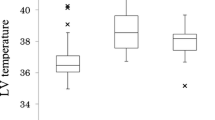Abstract
Introduction
In humans, raised body temperature is linked to poor outcome after brain injury. Because deviations between brain and body temperature have been reported after severe traumatic brain injury (TBI), the aim of this study was to explore the relationship between initial and mean brain temperature and survival at 3 months.
Methods
Intraparenchymal temperature was measured 3–4 cm within white matter. Logistic regression was used to explore linear and quadratic relationships between initial and average brain temperature and survival at 3 months.
Results
In 36 patients, initial brain temperatures ranged from 33.5 to 39.2°C (median 37.4°C). There was no evidence of an association between initial brain temperature and risk of death, either linear (odds ratio [OR] 95% confidence interval [CI]=1.3 [0.68 to 2.5], p=0.42) or quadratic (p=0.26). Assuming a linear relationship, patients with higher mean brain temperatures were less likely to die: OR (95% CI) for death per 1°C was 0.31 (0.09 to 1.1), p=0.06. However, by fitting the quadratic relationship, there was a suggestion that both high and low temperatures were associated with increased risk of death: p=0.06.
Conclusion
Initial brain temperature measured shortly after adminission did not predict outcome. There is a suggestion that patients with “middle range” temperatures were less likely to die.
Similar content being viewed by others
References
Azzimondi G, Bassein L, Nonino F, Fiorani L, Vignatelli L, D'Alessandro R. Fever in acute stroke worsens prognosis: a prospective study. Stroke 1995;26:2040–2043.
Reith J, Jorgensen HS, Pederson PM, et al. Body temperature in acute stroke: relation to stroke severity, infarct size, mortality and outcome. Lancet 1996;347:422–425.
Boysen G, Christensen H. Stroke severity determines body temperature in acute stroke. Stroke 2001;32:413–417.
Castillo J, Davalos A, Marrugat J, Noya M. Timing for feverrelated brain damage in acute ischaemic stroke. Stroke 1998;29: 2455–2260.
Stocchetti N, Rossi S, Zanier ER, Colombo A, Beretta L, Citerio G, Pyrexia in head injured patients admitted to intensive care. Intensive Care Med 2002;28:1555–1562.
Diringer MN, Reaven NL, Funk SE, Uman GC. Elevated body temprature independently contributes to increased length of stay in neurologic intensive care unit patients. Crit Care Med 2004;32:1489–1495.
Brinnel H, Cabanac M, Hales JRS. Critical upper levels of body temperature, tissue thermosensitivity and selective brain cooling in hyperthermia. In: Hales JRSR, ed. Heat Stress: Physical Exertion and Environment. Amsterdam: Excerpta Medica, 1987: 209–240.
Childs C, Harrison R, Hodkinson C. Tympanic membrane temperature as a measure of core temperature. Arch Dis Child 1999; 80:262–266.
Childs C, Hadcock J, Ray A, King AT, Protheroe R. Temperature measurement after severe head injury. Anaesthesia 2004;59:192–193.
Gupta AK, Al-Rawi PG, Hutchinson PJ, Kirkpatrick PJ. Changes in brain tissue oxygenation with brain temperature in severely head injured patients. Br J Neurosurg 2000;14:208.
Rumana CS, Gopinath SP, Uzura M, Valadka AB, Robertson CS. Brain temperature exceeds systemic temperature in head-injured patients. Crit Care Med 1998;26:562–567.
Henker RA, Brown SD, Marion DW. Comparison of brain temperature with bladder and rectal temperatures in adults with severe head injury. Neurosurgery 1998;42:1071–1075.
Childs C, Vail A, Protheroe R, King AT, Dark PM. Differences between brain and rectal temperatures during routine critical care of patients with severe traumatic brain injury. Anaesthesia 2005;60: 759–765.
Mellergard P. Intracerbral temperature in neurosurgical patients: intracranial temperature gradients and relationships to consciousness level. Surg Neurol 1995;43:91–95.
Mellergard P, Nordstrom C-H. Intracerebral temperature in neurosurgical patients. Neurosurgery 1991;28:709–713.
Otawara Y, Ogasawara K, Kubo Y, Tomitsuka N, Ogawa A, Suzuki M. Brain and systemic temperature in patients with severe subarachnoid hemorrhage. Surg Neurol 2003;60:159–164.
Bouma GJ, Muizelaar JP, Stringer WA, Choi SC, Fatouros P, Young HF. Ultra-early evaluation of regional cerebral blood flow in severely head-injured patients using xenon-enhanced computerized tomography. J Neurosurg 1992;77:360–368.
Jaggi JL, Obrist WD, Gennarelli TA, Lagfitt TW. Relationship of early cerebral blood flow and metabolism to outcome in acute head injury. J Neurosurg 1990;72:176–182.
Baker SP, O'Neill B, Haddon W, Long WB. The injury severity score: a method for describing patients with multiple injuries and evaluating emergency care. J Trauma 1974;14:187–196.
Manno EM, Farner JC. Acute brain injury: If hypothermia is good, then is hyperthermia bad? Crit Care Med 2004;32:1611–1612.
Soukup J, Zauner A, Doppenberg EMR, et al. The importance of brain temperature in patients with severe head injury: relationship to intracranial pressure cerebral perfusion pressure, cerebral blood flow and outcome. J Neurotrauma 2002;19:559–571.
Little RA, Stoner HB. Body temperature after accidental injury. Br J Surg 1981;68:221–224.
Stoner HB. A role for the central nervous system in the responses to trauma. In: Little RA, Frayn KN, eds. The Scientific Basis for the Care of the Critically III. Manchester: Manchester University Press, 1986:215–229.
Busto R, Dietrich WD, Globus MY, Valdes I, Scheinberg P, Ginsberg MD. Small differences in intraischemic brain temperature critically determine the extent of ischaemic neuronal injury. J Cereb Blood Flow Metab 1987;7:729–738.
Dietrich WD, Alonso O, Halley M, Busto R. Delayed posttraumatic brain hyperthermia worsens outcome after fluid percussion brain injury: a light and electron microscopic study in rats. Neurosurgery 1996;38:533–541.
Mellergard P. Monitoring of rectal, epidural, and intraventricular temperature in neurosurgical patients. Acta Neurochir 1994; 60(Suppl):485–487.
Clifton GL, Miller ER, Choi SC, et al. Lack of effect of induction of hypothermia after acute brain injury. N Engl J Med 2001; 344:556–563.
Thompson HJ, Hoover RC, Tkacs NC, Saatman KE, McIntosh TK. Development of posttraumatic hyperthermia after traumatic brain injury in rats is associated with increased periventricular inflammation. J Cereb Blood Flow Metab 2005;25:163–176.
Author information
Authors and Affiliations
Corresponding author
Rights and permissions
About this article
Cite this article
Childs, C., Vail, A., Leach, P. et al. Brain temperature and outcome after severe traumatic brain injury. Neurocrit Care 5, 10–14 (2006). https://doi.org/10.1385/NCC:5:1:10
Issue Date:
DOI: https://doi.org/10.1385/NCC:5:1:10




